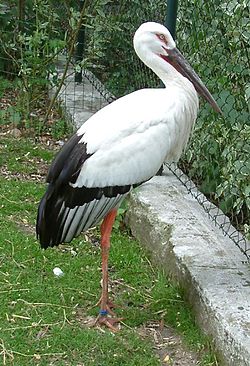鸛
| ||||||||
Translingual[edit]
| Traditional | 鸛 |
|---|---|
| Shinjitai (extended) |
⿰𮥶鳥 |
| Simplified | 鹳 |
Han character[edit]
鸛 (Kangxi radical 196, 鳥+18, 29 strokes, cangjie input 廿土竹日火 (TGHAF), four-corner 47227, composition ⿰雚鳥)
References[edit]
- Kangxi Dictionary: page 1504, character 39
- Dai Kanwa Jiten: character 47500
- Dae Jaweon: page 2034, character 11
- Hanyu Da Zidian (first edition): volume 7, page 4670, character 22
- Unihan data for U+9E1B
Chinese[edit]
| trad. | 鸛 | |
|---|---|---|
| simp. | 鹳 | |
| alternative forms | 雚 | |
Glyph origin[edit]
Phono-semantic compound (形聲/形声, OC *koːns) : phonetic 雚 (OC *koːns, “stork”) + semantic 鳥 (“bird”). Originally written 雚.
Pronunciation[edit]
Definitions[edit]
鸛
- stork
- crane (Grus japonensis)
- Used in 鵝鸛/鹅鹳 (éguàn).
Compounds[edit]
Japanese[edit]
| ⿰𮥶鳥 | |
| 鸛 |
Kanji[edit]
(uncommon “Hyōgai” kanji, kyūjitai kanji, shinjitai form ⿰𮥶鳥)
Readings[edit]
- Go-on: かん (kan)←くわん (kwan, historical)
- Kan-on: かん (kan)←くわん (kwan, historical)
- Kun: こうのとり (kōnotori, 鸛)←こふのとり (kofunotori, 鸛, historical)
Etymology 1[edit]
| Kanji in this term |
|---|
| 鸛 |
| こうのとり Hyōgaiji |
| kun’yomi |
Compound of 鸛 (kō, “Oriental stork”, see below) + の (no, attributive particle) + 鳥 (tori, “bird”).
Pronunciation[edit]
- (Tokyo) こーのとり [kòónóꜜtòrì] (Nakadaka – [3])[1][2]
- (Tokyo) こーのとり [kóꜜònòtòrì] (Atamadaka – [1])[1][2]
- IPA(key): [ko̞ːno̞to̞ɾʲi]
Noun[edit]
鸛 or 鸛 • (kōnotori) ←こふのとり (kofunotori) or コフノトリ (kofunotori)?
- Oriental stork (Ciconia boyciana)
- Synonym: 鸛鶴 (kōzuru)
- (by extension) any stork
Usage notes[edit]
As with many terms that name organisms, this term is often spelled in katakana, especially in biological contexts (where katakana is customary), as コウノトリ.
Etymology 2[edit]
| Kanji in this term |
|---|
| 鸛 |
| こう Hyōgaiji |
| kun’yomi |
/kan/ → /kau/ → /koː/
Pronunciation[edit]
Noun[edit]
鸛 or 鸛 • (kō) ←こふ (kofu) or コフ (kofu)?
As with many terms that name organisms, this term is often spelled in katakana, especially in biological contexts (where katakana is customary), as コウ.
Derived terms[edit]
- 鸛鶴 (kōzuru)
- 青嘴鸛 (aohashikō, “white-bellied stork (Ciconia abdimii)”)
- 朱嘴鸛 (akahashikō)
- 燕尾鸛 (enbikō, “maguari stork (Ciconia maguari)”)
- 鞍嘴鸛 (kurahashikō)
- 朱嘴鸛 (shubashikō, “white stork (Ciconia ciconia)”)
- 白襟鸛 (shiroerikō, “Asian woolly-necked stork (Ciconia episcopus)”)
- 朱鷺鸛 (tokikō)
- 鍋鸛 (nabekō, “black stork (Ciconia nigra)”)
- 禿鸛 (hagekō)
- 嘴広鸛 (hashibirokō, “shoebill (Balaeniceps rex)”)
References[edit]
- ↑ 1.0 1.1 NHK Broadcasting Culture Research Institute, editor (1998), NHK日本語発音アクセント辞典 [NHK Japanese Pronunciation Accent Dictionary] (in Japanese), Tōkyō: NHK Publishing, →ISBN
- ↑ 2.0 2.1 2.2 Matsumura, Akira, editor (2006), 大辞林 (in Japanese), Third edition, Tōkyō: Sanseidō, →ISBN
Korean[edit]
Hanja[edit]
鸛 • (gwan) (hangeul 관, revised gwan, McCune–Reischauer kwan, Yale kwan)
- crane (Grus japonensis)
- stork (Ciconia species)
Vietnamese[edit]
Han character[edit]
- This term needs a translation to English. Please help out and add a translation, then remove the text
{{rfdef}}.
- CJK Unified Ideographs block
- Han script characters
- Translingual lemmas
- Translingual symbols
- Han phono-semantic compounds
- Middle Chinese lemmas
- Old Chinese lemmas
- Chinese lemmas
- Mandarin lemmas
- Cantonese lemmas
- Hokkien lemmas
- Chinese nouns
- Mandarin nouns
- Cantonese nouns
- Hokkien nouns
- Chinese terms with IPA pronunciation
- Chinese Han characters
- zh:Cranes (birds)
- Japanese Han characters
- Uncommon kanji
- Japanese kanji with goon reading かん
- Japanese kanji with historical goon reading くわん
- Japanese kanji with kan'on reading かん
- Japanese kanji with historical kan'on reading くわん
- Japanese kanji with kun reading こうのとり
- Japanese kanji with historical kun reading こふのとり
- Japanese terms spelled with 鸛
- Japanese terms read with kun'yomi
- Japanese compound terms
- Japanese terms with IPA pronunciation
- Japanese lemmas
- Japanese nouns
- Japanese terms with multiple readings
- Japanese terms spelled with hyōgaiji kanji
- Japanese terms written with one Han script character
- Japanese single-kanji terms
- ja:Storks
- Korean lemmas
- Korean Han characters
- Vietnamese Chữ Hán
- Vietnamese lemmas
- Vietnamese Han characters

